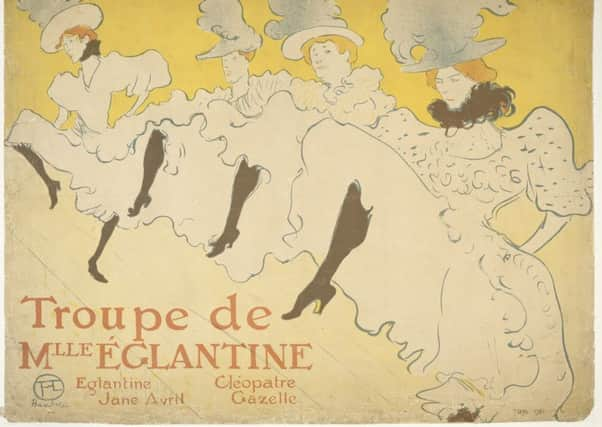Edinburgh exhibition to celebrate '˜Belle Epoque' celebrity era


Now a major new exhibition in Scotland is set to recall how the city gave birth to the cult of celebrity thanks to the artists and designers whose work instantly evokes the “Belle Epoque” era.
The National Galleries of Scotland in Edinburgh will be playing host to dozens of posters, prints, paintings and drawings created by some of the city’s finest artists and designers to promote acts playing at celebrated venues like the Moulin Rouge and the Ambassadeurs.
Advertisement
Hide AdAmong the Parisian night-life stars it will celebrate are can-can dancers Jane Arvil and La Goulue, and the cabaret singers Yvette Guilbert and Aristide Bruant, who featured in many of the best-known publicity material.
Largely focusing on Henri de Toulouse-Lautrec, whose very first poster for La Goule at the Moulin will be on display, the exhibition will showcase the work of other leading Parisian artists from the era, including Pierre Bonnard, Théophile Alexandre Steinlen and Jules Chéret. It will also show how Scottish artists including JD Fergusson and Arthur Melville, were drawn to the bohemian atmosphere of the city in the last two decades of the century.
The exhibition will explore the life and legacy of Toulouse-Lautrec, as well as the various venues of the Montmartre district on the outskirts of Paris, where he worked and socialised in the late 19th century.
Hannah Brocklehurst, curator of prints and drawings at the National Galleries of Scotland, said: “Toulouse-Lautrec is remembered today for his iconic images of Paris’s celebrity elite and his colourful posters of fin-de-siècle Montmarte. It was the music hall and the cabaret that guaranteed his fame and fortune, and he was quickly accepted into the bohemian demi-monde.
“He was notoriously gregarious and his passions included food, entertaining, fancy dress and sport. He was also noted for his loyalty, kindheartedness, charm, intellect and remarkable psychological insight.
“However, his private story, like that of many celebrities today, was one of a constant struggle with alcohol abuse, self-doubt and, in his case, with the added challenges of physical disability.”
Advertisement
Hide AdFrances Fowle, senior curator of French art at the National Galleries, who co-curated the exhibition, said: “Celebrity worship is not only a 21st century phenomenon.
“Just as today’s stars and minor personalities court publicity, and willingly satisfy their fans’ desire to be shocked, delighted and horrified, this same need to remain constantly in the public eye motivated the world of entertainers in Paris in the 1880s.
Advertisement
Hide Ad“But whereas the Kim Kardashians of today use Instagram, Twitter and other social media to expand their circle of admirers, singers, impressionists and can-can dancers in the 1880s were promoted through the new medium of the poster.
“Of all the designers who emerged during this period, Toulouse-Lautrec was undoubtedly the most gifted and sought-after.
“The secret of his success was to build up a close relationship with each of his subjects, with the aim of identifying a particular trait, catchline or physical characteristic.
“He then used his skills as a draughtsman to capture the individual character or ‘essence’ of each performer, which he translated into a series of enticing and memorable images of Paris’s Belle Epoque.”
• Pin-Ups: Toulouse-Lautrec and the Art of Celebrity runs 6 October to 20 January 2019